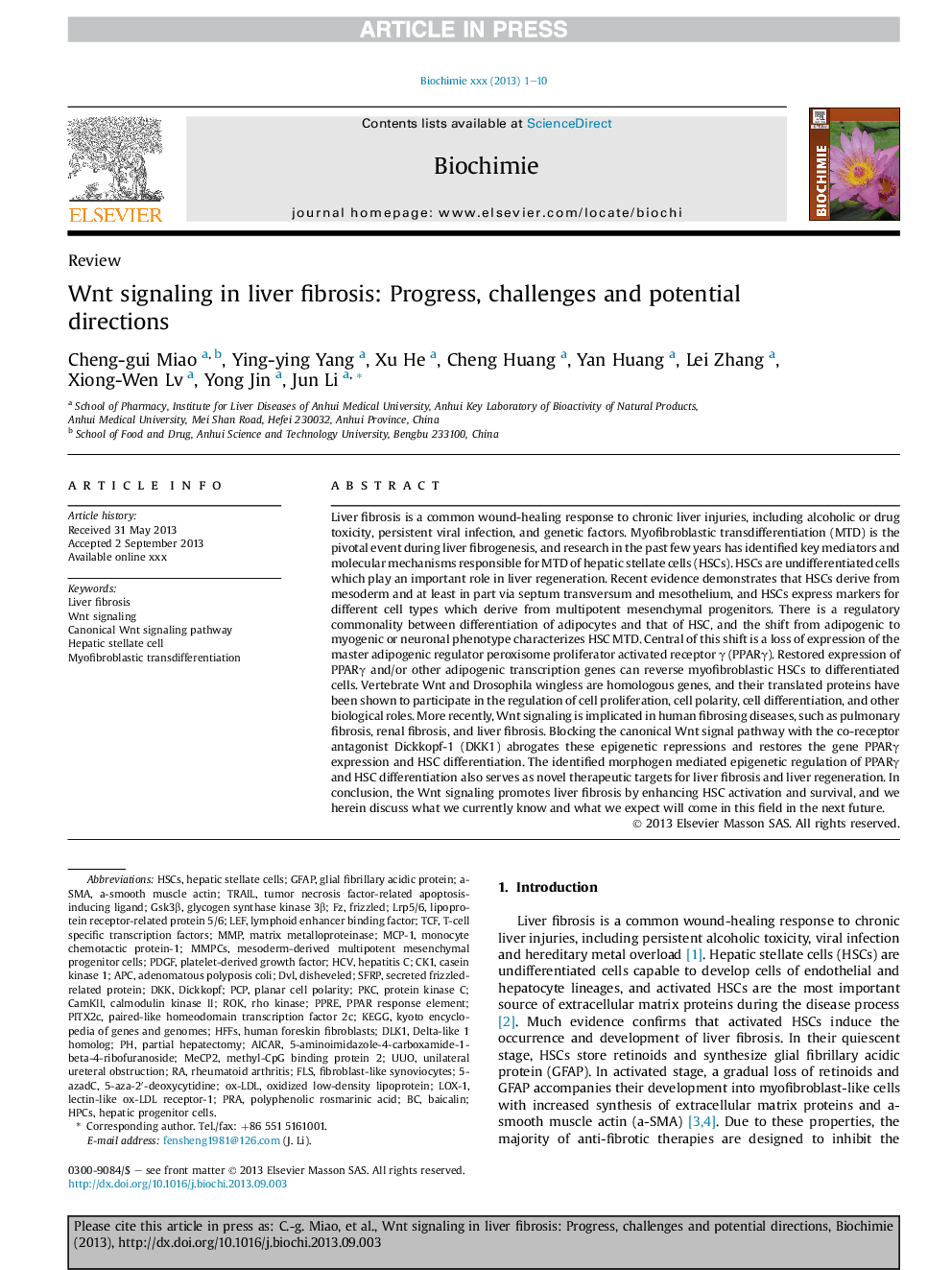| کد مقاله | کد نشریه | سال انتشار | مقاله انگلیسی | نسخه تمام متن |
|---|---|---|---|---|
| 10803661 | 1057176 | 2013 | 10 صفحه PDF | دانلود رایگان |
عنوان انگلیسی مقاله ISI
Wnt signaling in liver fibrosis: Progress, challenges and potential directions
دانلود مقاله + سفارش ترجمه
دانلود مقاله ISI انگلیسی
رایگان برای ایرانیان
کلمات کلیدی
Ox-LDLPKCMecp2GSK3βCK1BaicalinPRAHSCsfrizzledPDGFLOX-1Dlk1a-SMAsFRPUUOPITX2clymphoid enhancer binding factorKEGGTCFPCPGFAPMCP-1DVLFLSAPCAICARMMPCaMKII5-Aza-2′-deoxycytidine - 5-Aza-2'-deoxycytidineHPCs - HPC هاLRP5/6 - LRP5 / 6adenomatous polyposis coli - آدنوماتوز پولیپوزیس کولی یا آدنوماتوس پولیپوزیس کولای Rheumatoid arthritis - آرتریتروماتوئیدa-smooth muscle actin - آکتین عضله ای صافDkk - ات الdickkopf - ادم کودن و سرسختPPRE - ارسالUnilateral ureteral obstruction - انسداد مجاری مدفوع یک طرفهdisheveled - بی رحمKyoto Encyclopedia of Genes and Genomes - دایره المعارف ژنتیک ژن ها و ژنوم کیوتوDelta-like 1 homolog - دلتا مانند 1 همولوگRho kinase - رین کینازROK - سالHepatic stellate cell - سلول ستاره ای کبدیhepatic progenitor cells - سلول های پیش گیاه کبدیHepatic stellate cells - سلولهای ستارهای کبدیWnt signaling - سیگنال WntPPAR response element - عنصر پاسخ PPARplatelet-derived growth factor - فاکتور رشد حاصل از پلاکتhuman foreskin fibroblasts - فیبروبلاستهای مزرعه انسانی انسانLiver fibrosis - فیبروز کبدیTRAIL - قطارPlanar Cell Polarity - قطبش پلانارLef - لفOxidized low-density lipoprotein - لیپوپروتئین با چگالی کم اکسید شدهtumor necrosis factor-related apoptosis-inducing ligand - لیگاند ناشی از آپوپتوز وابسته به عامل بیماری تومورmatrix metalloproteinase - ماتریکس متالوپروتئینازfibroblast-like synoviocytes - مانند سینوویوسیت های فیبروبلاستPartial hepatectomy - هپاتکتومی جزئیHepatitis C - هپاتیت CHCV - هپاتیت سیMonocyte chemotactic protein-1 - پروتئین chemotactic monocyte-1Glial fibrillary acidic protein - پروتئین اسیدی فیبریلاسیون گلایالmethyl-CpG binding protein 2 - پروتئین متصل CpG متیل 2Secreted frizzled-related protein - پروتئین مرتبط با فروکتوز جدا شده استProtein kinase C - پروتئین کیناز سیcasein kinase 1 - کازئین کیناز 1calmodulin kinase II - کالدولون کیناز IIGlycogen synthase kinase 3β - گلیکوزین سنتاز کیناز 3β
موضوعات مرتبط
علوم زیستی و بیوفناوری
بیوشیمی، ژنتیک و زیست شناسی مولکولی
زیست شیمی
پیش نمایش صفحه اول مقاله

چکیده انگلیسی
Liver fibrosis is a common wound-healing response to chronic liver injuries, including alcoholic or drug toxicity, persistent viral infection, and genetic factors. Myofibroblastic transdifferentiation (MTD) is the pivotal event during liver fibrogenesis, and research in the past few years has identified key mediators and molecular mechanisms responsible for MTD of hepatic stellate cells (HSCs). HSCs are undifferentiated cells which play an important role in liver regeneration. Recent evidence demonstrates that HSCs derive from mesoderm and at least in part via septum transversum and mesothelium, and HSCs express markers for different cell types which derive from multipotent mesenchymal progenitors. There is a regulatory commonality between differentiation of adipocytes and that of HSC, and the shift from adipogenic to myogenic or neuronal phenotype characterizes HSC MTD. Central of this shift is a loss of expression of the master adipogenic regulator peroxisome proliferator activated receptor γ (PPARγ). Restored expression of PPARγ and/or other adipogenic transcription genes can reverse myofibroblastic HSCs to differentiated cells. Vertebrate Wnt and Drosophila wingless are homologous genes, and their translated proteins have been shown to participate in the regulation of cell proliferation, cell polarity, cell differentiation, and other biological roles. More recently, Wnt signaling is implicated in human fibrosing diseases, such as pulmonary fibrosis, renal fibrosis, and liver fibrosis. Blocking the canonical Wnt signal pathway with the co-receptor antagonist Dickkopf-1 (DKK1) abrogates these epigenetic repressions and restores the gene PPARγ expression and HSC differentiation. The identified morphogen mediated epigenetic regulation of PPARγ and HSC differentiation also serves as novel therapeutic targets for liver fibrosis and liver regeneration. In conclusion, the Wnt signaling promotes liver fibrosis by enhancing HSC activation and survival, and we herein discuss what we currently know and what we expect will come in this field in the next future.
ناشر
Database: Elsevier - ScienceDirect (ساینس دایرکت)
Journal: Biochimie - Volume 95, Issue 12, December 2013, Pages 2326-2335
Journal: Biochimie - Volume 95, Issue 12, December 2013, Pages 2326-2335
نویسندگان
Cheng-gui Miao, Ying-ying Yang, Xu He, Cheng Huang, Yan Huang, Lei Zhang, Xiong-Wen Lv, Yong Jin, Jun Li,